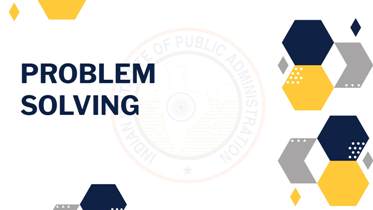
Introduction
Problems are at the heart of much of what people face on a daily basis and the capability to solve issues is a fundamental life skill that is required in our daily lives at home and workplace. The challenges a person confronts might be huge or little, simple or complicated, easy or tough and these could be work related intra / inter organisational issues or personal issues. The challenge lies in the ability solve the problems in an efficient and timely manner. According to a survey, one of the top five "extremely crucial" abilities for work success is problem solving.
Finding solutions to problems is an important element of any civil servants’ job. Thus, being a confident problem solver is critical to successful discharge of the assigned duties. ‘Efficiency’ is one of the pillars of Good Governance and Citizen Centric Administration and ‘Problem Solving’ is a key attribute of the ‘Efficiency’ pillar.
Author: Brigadier Amit Rao
Aim
To infuse better “Problem Solving” skills amongst civil servants as a part of Competency Based Training (CBT) under the Mission Karamyogi programme.
Problem and Problem Solving
The dictionary meaning of ‘Problem’ is a situation, person, or thing that needs attention and needs to be dealt with or solved. Genesis of the the word ‘problem’ comes from the Greek word ‘proballein’ wherein ‘pro’ means ‘before’ and ‘ballein’ means ‘to throw’ i.e. throwing up a question or a situation.
Problem-solving abilities are beneficial not only in one’s personal life but also in one’s work life. Employers frequently see everyday issue solving as critical to their businesses' success in today's fast-changing global market. Employees may utilise problem solving to generate practical and innovative solutions as well as demonstrate independence and initiative to their organisations.
Pathways to Problem Solving
The process of detecting a problem, generating viable solutions, and deciding on the best course of action is known as problem solving. In management, there have been multiple pathways to problem solving. An enduring model is the IDEAL model propagated by John D. Bransford and Barry S. Stein in 1993.
Identify problems and opportunities – The easiest method to figure out what's causing the problem is to ask questions and collect data. Investigating facts rather than assuming a solution is more effective if you have a complex challenge. Pose questions to yourself about the issue. What information do you have regarding the issue? What do you think you don't know? When was the last time it functioned properly? Since then, what has changed? Is it possible to break down the procedure into individual steps? Where does the issue arise in the process? Instead of making assumptions, be interested, ask questions, gather data, and draw logical inferences. At this phase, it is important to focus on the problem and avoid the desire to describe it in terms of a solution.
Define Goals - The next step is to define the desired goals in the problem context. This is not the same as identifying the issue. For example, a group of individuals may recognise the presence of a common problem and agree that it provides an opportunity, but they may disagree on what their goals should be. Different goals frequently represent different perspectives on a situation. When attempting to solve an issue, people frequently forget to explore alternate goals. Instead, they go right into the study of approaches to resolve the problem. An important part of goal defining also understands impacts on associated issues to that particular problem.
Explore Possible Strategies – With the information obtained in the previous two phases of the problem solving framework, one can start thinking about potential solutions to the identified problem. While considering possible strategies, assessing likely alternatives should be postponed at first. It is important to include all those who are involved in the decision-making process and to specify options that are in line with the goals planned in step two of the process. A thorough brainstorming of all viable options must include considering other people's suggestions and make a list of both short and long-term options.
Defining a perfect solution involves the following
Having identified likely options to solve the problem, it is critical to identify the most appropriate strategy. The following steps are imperative to decide on the suitable approach.
Anticipate Outcomes and Act - The necessity of recognising issues and chances to be creative, setting goals, and investigating ideas or tactics for solutions has been stressed. It's critical to foresee probable consequences after deciding on a plan and then acting on it. It is important evaluating the chosen solutions in numerous scenarios to predict probable results. It is also prudent to consider a worst-case scenario that may occur as it may point out to further refinement or fine tuning of the selected strategy. The apex of the problem-solving process lies in execution. This stage has three basic steps
Look and learn - The final phase of the IDEAL approach to problem solving involves examining the tangible results of the strategy and gaining new knowledge including assimilation of techniques that incorporates skills that may be applied in the workplace. A set of questions given below will enable successful fruition of the final step.
Conclusion
The IDEAL model is a very successful process framework for providing learning opportunities and serendipitous learning that may help individuals better understand difficulties and seek solutions to complicated situations.
It's crucial not to take one's own knowledge and experience for granted. Based on one's experiences, mistakes, and achievements, one's perspective and unique abilities must be refined. All civil servants will face a multitude of problem solving situations all through their careers and will be remembered the most for challenges handled and dealing with problems that could otherwise appear big, overpowering, or unnecessarily complex to others.
Recommended Reading Material
Books
Articles
Videos
GoI Documents